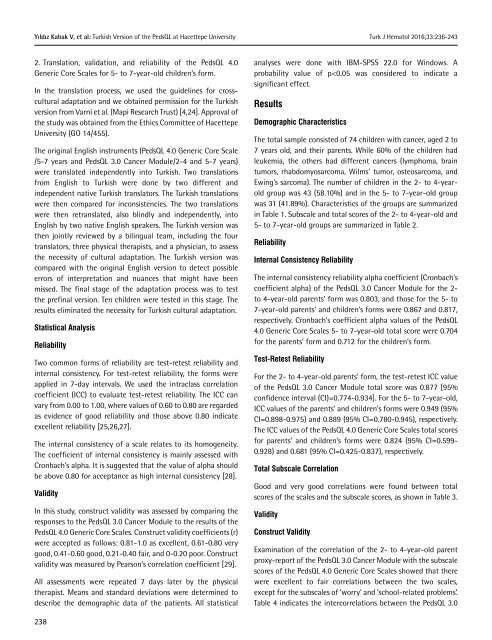Turkish Journal of Hematology Volume: 33 - Issue: 3
You also want an ePaper? Increase the reach of your titles
YUMPU automatically turns print PDFs into web optimized ePapers that Google loves.
Yıldız Kabak V, et al: <strong>Turkish</strong> Version <strong>of</strong> the PedsQL at Hacettepe University<br />
Turk J Hematol 2016;<strong>33</strong>:236-243<br />
2. Translation, validation, and reliability <strong>of</strong> the PedsQL 4.0<br />
Generic Core Scales for 5- to 7-year-old children’s form.<br />
In the translation process, we used the guidelines for crosscultural<br />
adaptation and we obtained permission for the <strong>Turkish</strong><br />
version from Varni et al. (Mapi Research Trust) [4,24]. Approval <strong>of</strong><br />
the study was obtained from the Ethics Committee <strong>of</strong> Hacettepe<br />
University (GO 14/455).<br />
The original English instruments (PedsQL 4.0 Generic Core Scale<br />
/5-7 years and PedsQL 3.0 Cancer Module/2-4 and 5-7 years)<br />
were translated independently into <strong>Turkish</strong>. Two translations<br />
from English to <strong>Turkish</strong> were done by two different and<br />
independent native <strong>Turkish</strong> translators. The <strong>Turkish</strong> translations<br />
were then compared for inconsistencies. The two translations<br />
were then retranslated, also blindly and independently, into<br />
English by two native English speakers. The <strong>Turkish</strong> version was<br />
then jointly reviewed by a bilingual team, including the four<br />
translators, three physical therapists, and a physician, to assess<br />
the necessity <strong>of</strong> cultural adaptation. The <strong>Turkish</strong> version was<br />
compared with the original English version to detect possible<br />
errors <strong>of</strong> interpretation and nuances that might have been<br />
missed. The final stage <strong>of</strong> the adaptation process was to test<br />
the prefinal version. Ten children were tested in this stage. The<br />
results eliminated the necessity for <strong>Turkish</strong> cultural adaptation.<br />
Statistical Analysis<br />
Reliability<br />
Two common forms <strong>of</strong> reliability are test-retest reliability and<br />
internal consistency. For test-retest reliability, the forms were<br />
applied in 7-day intervals. We used the intraclass correlation<br />
coefficient (ICC) to evaluate test-retest reliability. The ICC can<br />
vary from 0.00 to 1.00, where values <strong>of</strong> 0.60 to 0.80 are regarded<br />
as evidence <strong>of</strong> good reliability and those above 0.80 indicate<br />
excellent reliability [25,26,27].<br />
The internal consistency <strong>of</strong> a scale relates to its homogeneity.<br />
The coefficient <strong>of</strong> internal consistency is mainly assessed with<br />
Cronbach’s alpha. It is suggested that the value <strong>of</strong> alpha should<br />
be above 0.80 for acceptance as high internal consistency [28].<br />
Validity<br />
In this study, construct validity was assessed by comparing the<br />
responses to the PedsQL 3.0 Cancer Module to the results <strong>of</strong> the<br />
PedsQL 4.0 Generic Core Scales. Construct validity coefficients (r)<br />
were accepted as follows: 0.81-1.0 as excellent, 0.61-0.80 very<br />
good, 0.41-0.60 good, 0.21-0.40 fair, and 0-0.20 poor. Construct<br />
validity was measured by Pearson’s correlation coefficient [29].<br />
All assessments were repeated 7 days later by the physical<br />
therapist. Means and standard deviations were determined to<br />
describe the demographic data <strong>of</strong> the patients. All statistical<br />
analyses were done with IBM-SPSS 22.0 for Windows. A<br />
probability value <strong>of</strong> p

















